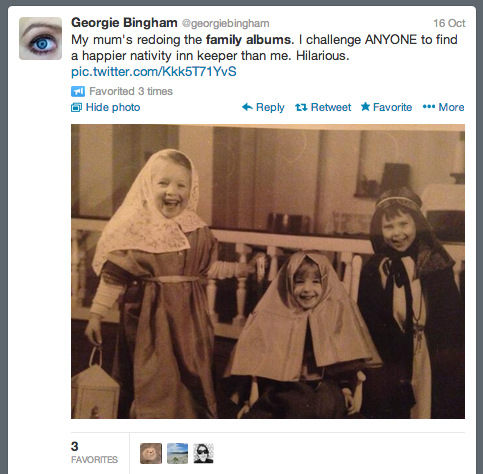What better way to research popular opinion about family photo albums than to have a look on Twitter.
I typed in the search bar ‘family albums’ and there are results. I can’t say it is a popular Twitter conversation. However still, it is interested to see that people still reflect on family albums. I can’t make the judgement that the amount of people who tweet about looking at an album is any kind of indication of how many people do in today’s society. Possibly it is our grandparents who look at the more often? Afterall that was the the medium of displaying and telling stories. Today however, it is the fluid image: the Instagram, the tweets and the Facebook pictures. We never fix the image in time in any physical sense: it’s sucked up into the world of the Internet.
Samsung suggests: “The growing trend in sharing photography online is also resulting in the death of the photo album,” [Telegraph]. I guess in one sense the physical album is ‘dying’ but family documentary is undeniably increasing with the availability of our cameras- on our phones. We back them up on platforms such as Instagram. It does beg the question: can the same emotions be felt scrolling through pixelated images as flicking over pages with different variations on photographs? I guess it depends on your environment: the digitally native may not feel anything from a book.
Should we be sad that there has only been 100 years of family albums before its ‘death’? I don’t think so, for “people are now taking more pictures than ever before, with an average of 1.9 billion photographs captured each month in Britain and 328 million of these shared online”. This is the new generation, we tell stories daily. We don’t miss out moments that maybe were before.
Dutch Curator Erik Kessel suggests that any one person makes about 8 photo albums in their lifetime:
1) A couple’s early romantic experiences- holidays etc
2) Marriage
3) First baby ( and if not, dog)
4-7) a mix mash of everything else and often with ‘blank pages’
“And in the eighth? “The eighth is comparable to the first. The couple are together, alone again because the kids have gone to university or left home. However, you can observe that the woman usually appears smaller in the frame, either because the man loses interest, she doesn’t want to be photographed or due to the fact that he’s more interested in the surrounding landscape.”
http://lightbox.time.com/2013/09/04/the-vanishing-art-of-the-family-photo-album/#ixzz2iTkPYmCp“Kessels is finely attuned to the voice of propaganda that rings sternly through out family photography, though he notes that this idea is not just specific to physical albums but is also present via avatars and profiles on Facebook, MobileMe, or Instagram, for example, in which people present carefully constructed images of themselves. Largely radiating happiness, such platforms allow for an all too perfect distillation of life, he says: the best situations, the best smiles, the sunniest of days.
Yet Kessels clearly has little concern for the neatly pruned. Instead, he actively seeks out the dissonant, the banal, and most crucially, the disruption to ritualised harmony within family photography. “A long and dedicated search through photo albums will occasionally reveal something less than perfection,” he says. “Something other than an entry in the competition to appear normal. And in these cracks, beauty may be found.””
Instagram's significance as a social network. This graph reveals its importance in US pic.twitter.com/xkn5Quhy0u (via @pkedrosky @jbenton)
— David Campbell (@davidc7) October 22, 2013
Kessel would argue that with the Instagram generation, we more than ever, curate what we want to share, as propaganda for the ‘happy family’. This tweet (shared by @davidc7) is a clear indication of the impact of family and personal documentary and how digital media is evolving the family album.

What a great post. I think you are spot on with the fluid (and transient) way pictures are digitally presented. Printed media, whether in an album/photobook or print/canvas/acrylic has much more impact but it does cost in terms of time and money. Maybe the digital age has nurtured the concept of the disposable memory. People will typically take a few snaps, show them to family and friends who will coo over them (not because they are technical masterpieces but because they either convey the flavour of an event to someone who wasn’t there, or trigger a memory for those who were. The picture is rubbish but the memory isnt?) then move on to their next family event, holiday etc and repeat the process again. Print, on the other hand, results in a less disposable memory probably because of the time/money aspect again.
http://www.picturestotreasure.com